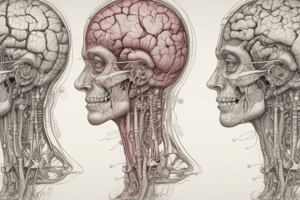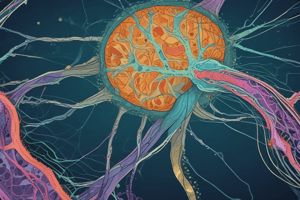Podcast
Questions and Answers
Which of the following is NOT considered a key aspect of the 'Introduction' to axon guidance?
Which of the following is NOT considered a key aspect of the 'Introduction' to axon guidance?
- Brain integration of sensory and motor information
- Nervous system connectivity
- Mechanisms of pathfinding becoming clearer
- Live imaging techniques in vivo (correct)
Growth cone dynamics are irrelevant for axon pathfinding.
Growth cone dynamics are irrelevant for axon pathfinding.
False (B)
Name three arbitrary zones of the growth cone.
Name three arbitrary zones of the growth cone.
actin filaments, microtubules, axon growth initiation
__________ (survival signals) are crucial for ensuring that axons reach their targets and survive.
__________ (survival signals) are crucial for ensuring that axons reach their targets and survive.
Match each axon guidance molecule to its general function:
Match each axon guidance molecule to its general function:
Which type of guidance mechanism involves physical cues?
Which type of guidance mechanism involves physical cues?
Electrical activity has no impact on axon survival during target contact.
Electrical activity has no impact on axon survival during target contact.
Name two families of cell adhesion molecules (CAMs) involved in axon guidance.
Name two families of cell adhesion molecules (CAMs) involved in axon guidance.
The neural tube utilizes _____, Semas, and Ephrins for repulsion, while _____ is used for attraction.
The neural tube utilizes _____, Semas, and Ephrins for repulsion, while _____ is used for attraction.
Match each developmental stage or factor with its effect on axon regeneration:
Match each developmental stage or factor with its effect on axon regeneration:
Visual field overlap in the retinotectal projection pathway is different between mammals and other vertebrates. Which of the following statements would most accurately describe a difference?
Visual field overlap in the retinotectal projection pathway is different between mammals and other vertebrates. Which of the following statements would most accurately describe a difference?
The retinotectal projection pathway is poorly understood.
The retinotectal projection pathway is poorly understood.
What is the mammalian equivalent of the tectum in the retinotectal projection pathway?
What is the mammalian equivalent of the tectum in the retinotectal projection pathway?
The optic ______ is the point at which axons from the retina cross to the opposite side of the brain.
The optic ______ is the point at which axons from the retina cross to the opposite side of the brain.
Match each term with its role in axon guidance:
Match each term with its role in axon guidance:
Which of the following best describes the role of 'target contact' in axon guidance?
Which of the following best describes the role of 'target contact' in axon guidance?
During developmental changes and axon regeneration, the postnatal CNS is generally supportive of axon regeneration.
During developmental changes and axon regeneration, the postnatal CNS is generally supportive of axon regeneration.
What broader ideas are included in the 'Introduction' part of Axon Guidance?
What broader ideas are included in the 'Introduction' part of Axon Guidance?
Growth cones use _____ to explore the environment for guidance cues.
Growth cones use _____ to explore the environment for guidance cues.
Associate each term with the described structure or process.
Associate each term with the described structure or process.
Flashcards
Brain Integration
Brain Integration
Integration of sensory and motor information in the brain for coordinated responses.
Nervous System Connectivity
Nervous System Connectivity
The interconnectedness of neurons and neural circuits within the nervous system.
Accurate Connectivity
Accurate Connectivity
Correct neural connections are vital for proper brain function and behavior.
Misconnectivity Consequences
Misconnectivity Consequences
Signup and view all the flashcards
Motile Sensory Tip
Motile Sensory Tip
Signup and view all the flashcards
Guidance Cue Exploration
Guidance Cue Exploration
Signup and view all the flashcards
Cytoskeleton Dynamics
Cytoskeleton Dynamics
Signup and view all the flashcards
Microtubule & Actin Interaction
Microtubule & Actin Interaction
Signup and view all the flashcards
Chemotropism
Chemotropism
Signup and view all the flashcards
Excess Axons Die Back
Excess Axons Die Back
Signup and view all the flashcards
Neurotrophins
Neurotrophins
Signup and view all the flashcards
Immunoglobulin CAMs
Immunoglobulin CAMs
Signup and view all the flashcards
Netrins
Netrins
Signup and view all the flashcards
Slits
Slits
Signup and view all the flashcards
Ephrins
Ephrins
Signup and view all the flashcards
Combinatorial Guidance
Combinatorial Guidance
Signup and view all the flashcards
cAMP Activity
cAMP Activity
Signup and view all the flashcards
Retinotectal Pathway
Retinotectal Pathway
Signup and view all the flashcards
Optic Chiasm
Optic Chiasm
Signup and view all the flashcards
Tectum
Tectum
Signup and view all the flashcards
Study Notes
- Axon Guidance
Introduction
- Axon guidance involves the integration of sensory and motor information in the brain.
- Nervous system connectivity is crucial for function.
- Accurate connectivity is important.
- Misconnectivity can have negative consequences.
- Mechanisms of pathfinding are becoming clearer.
Growth Cone
- Axons and dendrites have a motile sensory tip in growing neurons.
- Growth cones display dynamic behavior in vitro.
- Growth cones explore the environment for guidance cues.
- Growth cones form focal contacts for elongation.
- Knowledge about growth cones is derived from tissue culture.
- Molecular biology is uncovering the proteins involved in growth cone function.
- Live imaging techniques are used to study growth cones in vivo.
- Cytoskeleton dynamics are crucial for pathfinding.
- Microtubule and actin interaction plays a key role.
- Growth cones have three arbitrary zones.
- Actin filaments are important components.
- Microtubules are essential for growth cone function.
- Axon growth is initiated by the growth cone.
- Signal transduction is involved in growth cone guidance.
Growth Cone Guidance Mechanisms
- Chemical (chemotropism) factors guide growth cones.
- Physical cues guide growth cones.
- Electrical signals influence growth cone guidance.
Target Contact
- Excess axons retract during development.
- Target contact ensures necessary connections.
- Neurotrophins act as survival signals for neurons.
- Electrical activity promotes neuronal survival.
Key Axon Guidance Molecules
- Immunoglobulin (Ig) superfamily CAMs (cell adhesion molecules) guide axons.
- Cadherins guide axons.
- Extracellular matrix molecules guide axons.
- Netrins are axon guidance molecules.
- Slits are axon guidance molecules.
- Semaphorins are axon guidance molecules.
- Ephrins are axon guidance molecules.
- Myelin proteins guide axons.
Combinatorial Guidance Signals
- In grasshopper limbs, Semas act through physical mechanisms.
- Neural tube commissural axons are guided by:
- BMPs
- Semas
- Ephrins (repulsion)
- Netrin (attraction)
- Slits (repulsion after crossing)
Developmental Changes and Axon Regeneration
- Immature nervous system is supportive of axon growth.
- Postnatal central nervous system is inhibitory to axon growth.
- Inhibitory molecules, like myelin, are upregulated after development.
- Slow nerve degeneration occurs in the central nervous system.
- Intrinsic neuronal changes are important for regeneration.
- cAMP activity influences axon regeneration.
- Receptor expression changes, such as semaphorin receptors in RGCs, affect axon guidance.
- Signaling molecule changes within the growth cone influence axon behavior.
Retinotectal Projection Pathway
- The retinotectal projection pathway is the best-studied pathway for axon guidance.
- It involves accurate topographical guidance from the retina to the tectum.
- Studies have been conducted in vertebrates such as frogs, chicks, and zebrafish.
- The mammalian equivalent is the projection from the superior colliculus to the LGN to the cortex.
- There are differences in the visual field overlap between mammals and other species.
- The optic chiasm involves crossing patterns of axons.
- Retinal axon growth is a key process.
- The optic nerve head (ONH) is involved in the pathway.
- The optic chiasm is a crucial structure.
- The optic tract carries visual information.
- The tectum is the target structure in the brain.
Studying That Suits You
Use AI to generate personalized quizzes and flashcards to suit your learning preferences.



